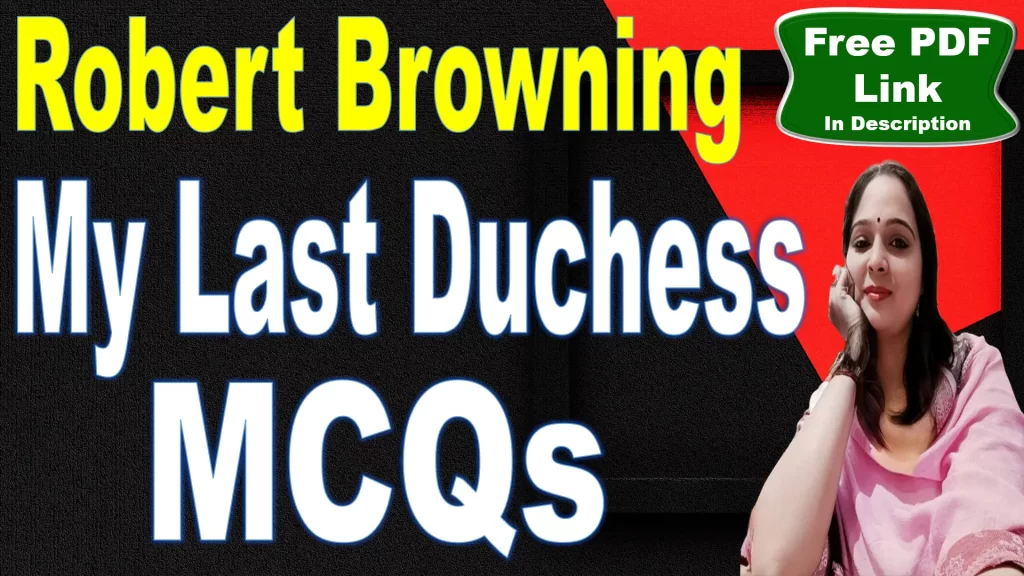
31. Which literary device is prominent in “Will’t please you sit and look at her?”
A. Irony
B. Symbolism
C. Rhetorical question
D. Hyperbole
Answer: C. Rhetorical question
Explanation: The Duke uses a rhetorical question when he says, “Will’t please you sit and look at her?” He does not genuinely seek an answer but instead uses the question to control the interaction, subtly forcing the emissary to focus on the portrait. The question is a manipulation tactic that aligns with the Duke’s need to direct and dominate the situation.
32. The Duke’s description of the Duchess’s smile can best be described as:
A. Admiring
B. Resentful
C. Indifferent
D. Playful
Answer: B. Resentful
Explanation: The Duke describes the Duchess’s smile with resentment, viewing it as something she shared with everyone, not just him. He perceives her warmth and generosity toward others as a flaw, implying that she should have reserved such affection for him alone. His attitude towards her smile highlights his jealousy and possessiveness.
33. What is ironic about the Duke’s statement, “I have not skill in speech”?
A. The Duke is actually very eloquent.
B. The Duke stammers throughout the poem.
C. The Duke never finishes his sentences.
D. The Duke refuses to speak about art.
Answer: A. The Duke is actually very eloquent.
Explanation: The Duke claims to lack skill in speech, but throughout the poem, he speaks in a highly eloquent, calculated, and manipulative manner. This is ironic because his words are carefully chosen to display his control, arrogance, and psychological complexity. His assertion of humility contrasts with his actual eloquence and reveals his self-deception and manipulation.
34. What does the Duke’s mention of “nine-hundred-years-old name” signify?
A. His pride in his heritage
B. His love for the Duchess
C. His modesty
D. His disdain for wealth
Answer: A. His pride in his heritage
Explanation: The Duke’s reference to his “nine-hundred-years-old name” signifies his pride in his aristocratic heritage. He believes that his family’s long history and noble status are of utmost importance and should be respected by those around him. This sense of entitlement shapes his actions and influences how he perceives the Duchess’s behavior toward him.
35. What is the significance of the dramatic monologue form in My Last Duchess?
A. It allows insight into the Duke’s mind.
B. It emphasizes the Duchess’s perspective.
C. It highlights multiple points of view.
D. It creates a dialogue between characters.
Answer: A. It allows insight into the Duke’s mind
Explanation: The dramatic monologue form is crucial in My Last Duchess because it allows the reader to gain insight into the Duke’s thoughts, emotions, and motivations. Through his speech, the Duke reveals his possessive and controlling nature without realizing that his words expose his true character. The form enables a deep psychological exploration of the Duke’s psyche.
36. How does the Duke describe the Duchess’s manner of thanking others?
A. Warm and genuine
B. Equal and indiscriminate
C. Reserved and distant
D. Critical and ungrateful
Answer: B. Equal and indiscriminate
Explanation: The Duke criticizes the Duchess for treating everyone equally and thanking them in the same manner. To him, this shows a lack of discernment and respect for his noble status, as he believes she should have reserved her gratitude for him alone. This criticism reflects the Duke’s possessiveness and his need for exclusive affection and loyalty.
37. What quality of the Duchess does the Duke consider a flaw?
A. Her love for art
B. Her innocence and joy
C. Her intelligence
D. Her devotion to him
Answer: B. Her innocence and joy
Explanation: The Duke considers the Duchess’s innocence and joy a flaw because she expresses happiness freely and openly, without considering the social hierarchy or his authority. To him, her joy should have been reserved for him alone, and her ability to find joy in simple things is perceived as a sign of disrespect. This reveals the Duke’s possessive and controlling nature.
38. What kind of power does the Duke exercise over the Duchess’s portrait?
A. Artistic power
B. Social power
C. Absolute control
D. Financial power
Answer: C. Absolute control
Explanation: The Duke exercises absolute control over the Duchess’s portrait, a symbol of his power and possessiveness. He controls who can see the painting and when, drawing a curtain to hide it from view. This control is extended even after her death, showcasing his desire to dominate her image and legacy. By managing the portrait’s display, the Duke ensures that the Duchess is remembered on his terms, maintaining power over her even in memory.
39. The Duke’s jealousy arises primarily from:
A. The Duchess’s beauty
B. The Duchess’s interaction with others
C. The Duchess’s disobedience
D. The Duchess’s intelligence
Answer: B. The Duchess’s interaction with others
Explanation: The Duke’s jealousy stems from the Duchess’s innocent and open interactions with everyone around her. She treated all people with equal kindness, which he saw as a sign of disrespect. To him, her behavior diminished his status, as he believed her attention and affection should have been reserved exclusively for him. This jealousy over her friendliness and lack of deference fuels his frustration, eventually leading to his actions against her.
40. What does the curtain symbolize in the poem?
A. The Duke’s secrecy
B. The Duke’s control over the Duchess’s memory
C. The Duchess’s modesty
D. The Duke’s wealth
Answer: B. The Duke’s control over the Duchess’s memory
Explanation: The curtain in the poem symbolizes the Duke’s control over the Duchess’s memory and how she is viewed by others. The Duke alone draws the curtain to reveal the portrait, implying that only he has the right to present her image to the world. This act of controlling access to the portrait reflects the Duke’s obsession with maintaining power over every aspect of her life, even after her death, ensuring that her legacy is shaped entirely by his perspective.






Very interesting topic, regards for posting.